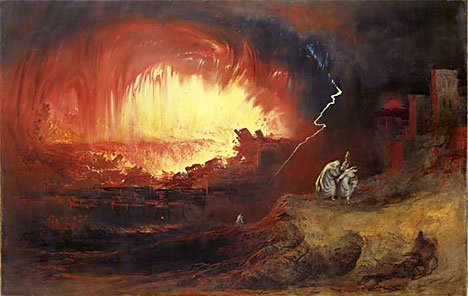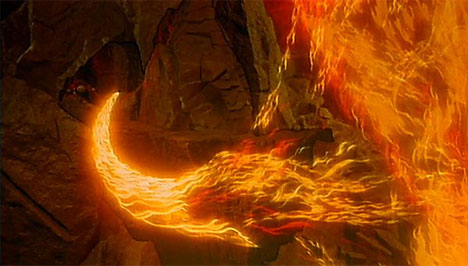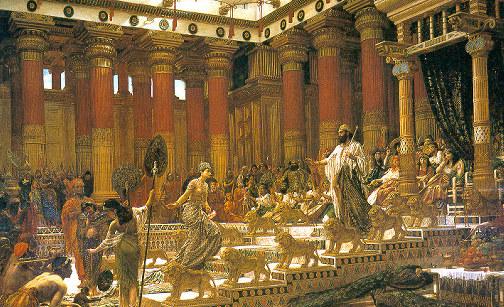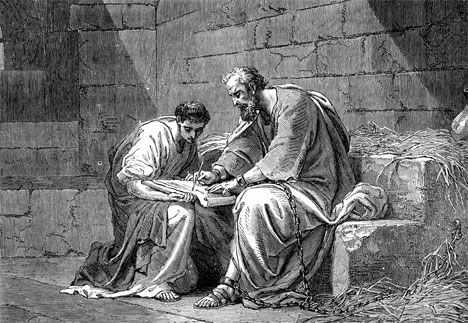Feb
21
2012
or The New Jerusalem has a Moat

“I know your works: you are neither cold nor hot.
Would that you were either cold or hot!” (Revelation 3:15)
The world is a cosmic Tabernacle. The first domain of Mediatory Man was between the waters. The waters below (springs) were necessary for life but they were not “a place to live.” The waters above did likewise. However, these were temporary veils, boundaries to be crossed in an increasing advance-by-faith.
Continue reading
Comments Off | tags: Creation Week, Crystal Sea, Genesis, Laver, New Jerusalem, Noah, Revelation, Tabernacle, The flood | posted in Bible Matrix, Biblical Theology, Creation, The Last Days
Feb
14
2012

“Let this mind be in you which was also in Christ Jesus, who, being in the form of God, did not consider it robbery to be equal with God, but made Himself of no reputation, taking the form of a bondservant, and coming in the likeness of men. And being found in appearance as a man, He humbled Himself and became obedient to the point of death, even the death of the cross. Therefore God also has highly exalted Him and given Him the name which is above every name, that at the name of Jesus every knee should bow, of those in heaven, and of those on earth, and of those under the earth, and that every tongue should confess that Jesus Christ is Lord, to the glory of God the Father.” (Philippians 2:5-11)
This passage (or pericope?) retraces the Covenant pattern, which is also played out in the flow of the history of Israel. We’ll have a look at the structure of the passage and then I want to discuss the significance of the literary placement of “every tongue.”
WARNING: Weird ahead.
[This post has been refined and included in Sweet Counsel: Essays to Brighten the Eyes.]
Continue reading
2 comments | tags: Achan, AD70, Babel, Babylon, Circumcision, Covenant Theology, Evangelism, Genesis, Herod, Joshua, Moses, Pentecost, Philippians, Postmillennialism, Systematic typology, Tabernacle, Tongues | posted in Bible Matrix, Biblical Theology, The Last Days
Feb
6
2012
or Ethnic Cleansing as Mercy

“In representative terms, the people of God are no longer the Land but the heavenly Sea. The Church herself is the oncoming storm.”
In The Days of Vengeance [PDF], David Chilton did a great job of introducing many of us to the fact of Jesus’ use of “cosmic language” in Matthew 24 to describe the end of the Old Covenant. Not only is the idea of an actual, physical star falling to earth impossible (can you imagine the sun “falling to earth”?) but Jesus is quoting from a prophecy against Babylon. His audience would have realized this as a scathing attack against the Herods and their “government controlled” Temple worship. So, the language is clearly poetic, but why would the prophets—and Jesus and His apostles—deliberately cause so much confusion by using cosmic language to describe non-cosmic events? The answer is found in the mercy of God.
Continue reading
3 comments | tags: AD70, Baptism, Circumcision, Communion, Postmillennialism, Tabernacle, Temple | posted in Against Hyperpreterism, Bible Matrix, Biblical Theology, The Last Days
Jan
28
2012

“For by one Spirit are we all baptized into one body,
whether we be Jews or Gentiles, whether we be bond or free;
and have been all made to drink into one Spirit.” 1 Cor. 12:13
On the BH forum, Michael Jones observed:
“If you look up the words for “drinking into” lexically (Strong’s), you come up with the idea of plants being irrigated and soaking up water through the roots. Is this somewhat valid? Are we like a bunch of trees around an oasis in the desert?” [1]
I believe that very often, the word choices of the biblical writers are hints to the literary structure — especially when their word choices are a little unexpected or ambiguous. This one isn’t unexpected, but perhaps that’s because we are so familiar with this passage. It really is an odd turn of phrase. Could the Bible Matrix shed any light on it?
Continue reading
Comments Off | tags: Baptism, Covenant Theology, Exodus, Feasts, Galatians, Literary Structure, Paul, Systematic typology, Tabernacle, Veil | posted in Bible Matrix, Biblical Theology
Dec
19
2011

The systematic typology of the Bible Matrix allows us to follow the structures of the Torah thoughout the rest of the Bible. Here’s something that links the Restoration era with the book of Deuteronomy.
Continue reading
Comments Off | tags: Baptism, Deuteronomy, Esther, Exodus, James Jordan, Jeremiah, Mordecai, Moses, Systematic typology, Tabernacle, Ten Commandments, The Law | posted in Biblical Theology, Quotes, The Restoration Era
Dec
3
2011
1 Peter 2:4-10 | Sermon Notes

The Stoning of Israel
I think it’s worth looking at the literary structure of this passage. Here’s a revised version of the sheet I handed out after the sermon.
As I’ve written before, modern readers (and commentators) only look at the content of the text, but the authors of Scripture also communicate to us through where they place that content within that text, i.e. how it is arranged.
Continue reading
1 comment | tags: Baptism, Covenant curse, Covenant Theology, Literary Structure, Lot, Moses, Peter, Ruth, Systematic typology, Tabernacle, The Law, Typology | posted in Bible Matrix, Biblical Theology
Nov
28
2011
1 Peter 2:4-10 | Sermon Notes

Cut and Uncut Stones
4 As you come to him, the living Stone—rejected by humans but chosen by God and precious to him—
Peter’s use of the stone image should bring many Old Testament images to mind:
- the precious stones of Havilah, intended to be mined from the Land to glorify the sanctuary [1]
- the false stones of Babel (they had brick for stone)
- Jacob’s head on the altar stone, in a deep sleep
- Jacob’s raising of an altar stone in Bethel: “And this stone which I have set as a pillar shall be God’s house, and of all that You give me I will surely give a tenth to You.”
- Zipporah’s sharp stone of circumcision
- Moses enthroned on a stone at the defeat of Amalek
- Israel’s altars of stone (one stone for each tribe) at Sinai and Carmel
- The precious stones on the breastplate of the High Priest
- The tablets of stone carrying the ten words
- The stones of the “Levitical” house in the city filled with plague
- The stones of judgment, the ground itself as a witness executing transgressors outside the camp
- The black and white stones in the ephod
We have two types of stones: uncut stones (altar, judgment – the Law) and cut, or precious, stones (glory and riches – Grace).
Continue reading
1 comment | tags: Circumcision, Exodus, Ezekiel, Genesis, Havilah, Hebrews, High Priest, Peter, Satan, Sinai, Solomon, Tabernacle, Temple | posted in Bible Matrix, Biblical Theology
Oct
31
2011
or The Cultic Core of Revelation

“Revelation is not just a vision of the King of Kings,
but of the King of Kings in His court.”
Preterists have a go at dispensationalists for interpreting the Bible through the lens of current headlines. We recognize that the Bible must be interpreted in its historical context, for its “first audience.” But there’s a brand of “newspaper exegesis” that plagues preterism as well.
Continue reading
Comments Off | tags: Dispensationalism, Ezekiel, James Jordan, Josephus, Kenneth Gentry, Moses, Preterism, Revelation, Tabernacle | posted in Biblical Theology, Quotes, The Last Days
Sep
7
2011

The description of Jesus in Revelation 1 follows the Bible’s new Creation matrix.
Jesus is the Word, and His manifestation is described in the pattern of the Creation Week. He is the Word made flesh, the Sacrament who “tabernacled” among us, and so is described in the pattern of the Tabernacle. He is the Word in Government, ruling over the pastors of the churches, and so we also see elements of the corresponding Dominion pattern.
Revelation is indeed a sublime book. Every stanza refracts the structure of every section, which in turn refracts the structure of the book, which in turn refracts the structure of the entire Bible. This literature comes from the mouth of the uncreated, the One who creates things fully formed from nothing; it is irreducibly complex. Nothing can be added, and nothing can be taken away.
Continue reading
10 comments | tags: James Jordan, Literary Structure, Revelation, Tabernacle | posted in Bible Matrix, Biblical Theology, Creation, The Last Days, Totus Christus
Aug
29
2011

“But when you do a charitable deed, do not let your left hand know what your right hand is doing…” Matthew 6:3
When it comes to doctrine, Mark Driscoll defines all issues as either closed-handed or open-handed. The non-negotiable fundamentals are held with a closed hand. In the open hand are issues that can be debated without shafting a church’s faithfulness to the apostles’ doctrine.
Continue reading
Comments Off | tags: Isaac, Mark Driscoll, Paul, Spiritual Growth, Tabernacle, Wisdom | posted in Biblical Theology, Christian Life



































